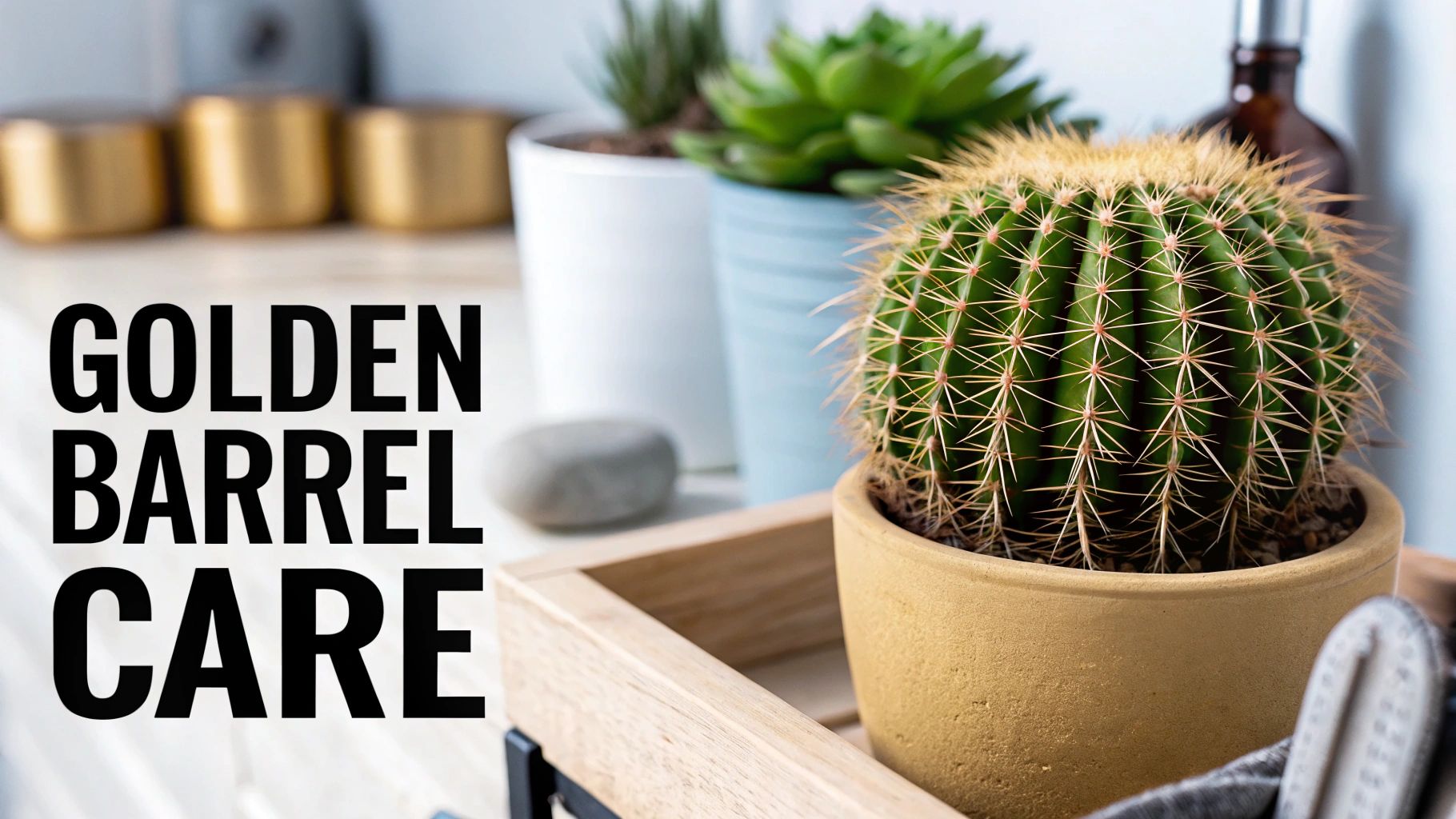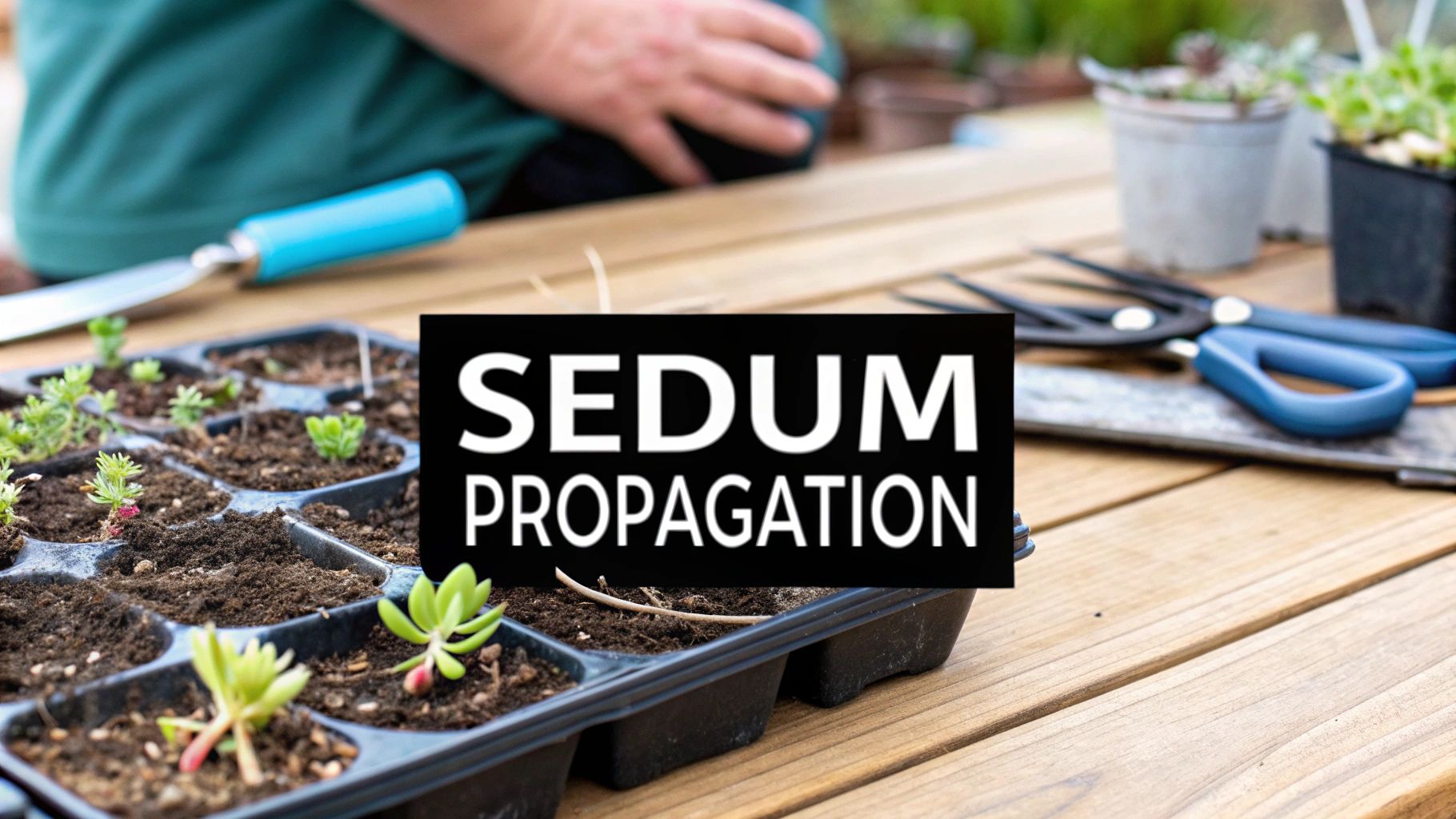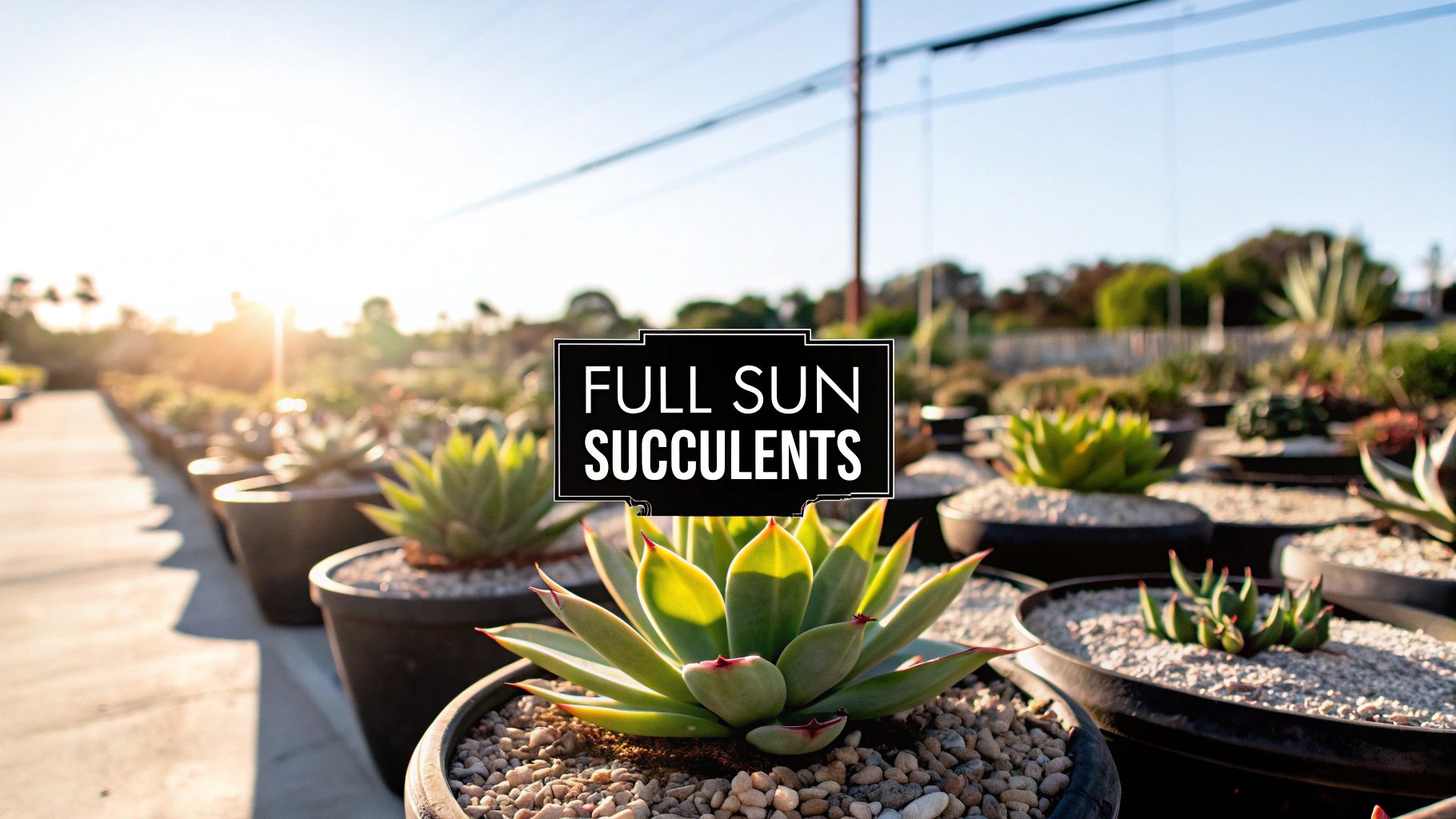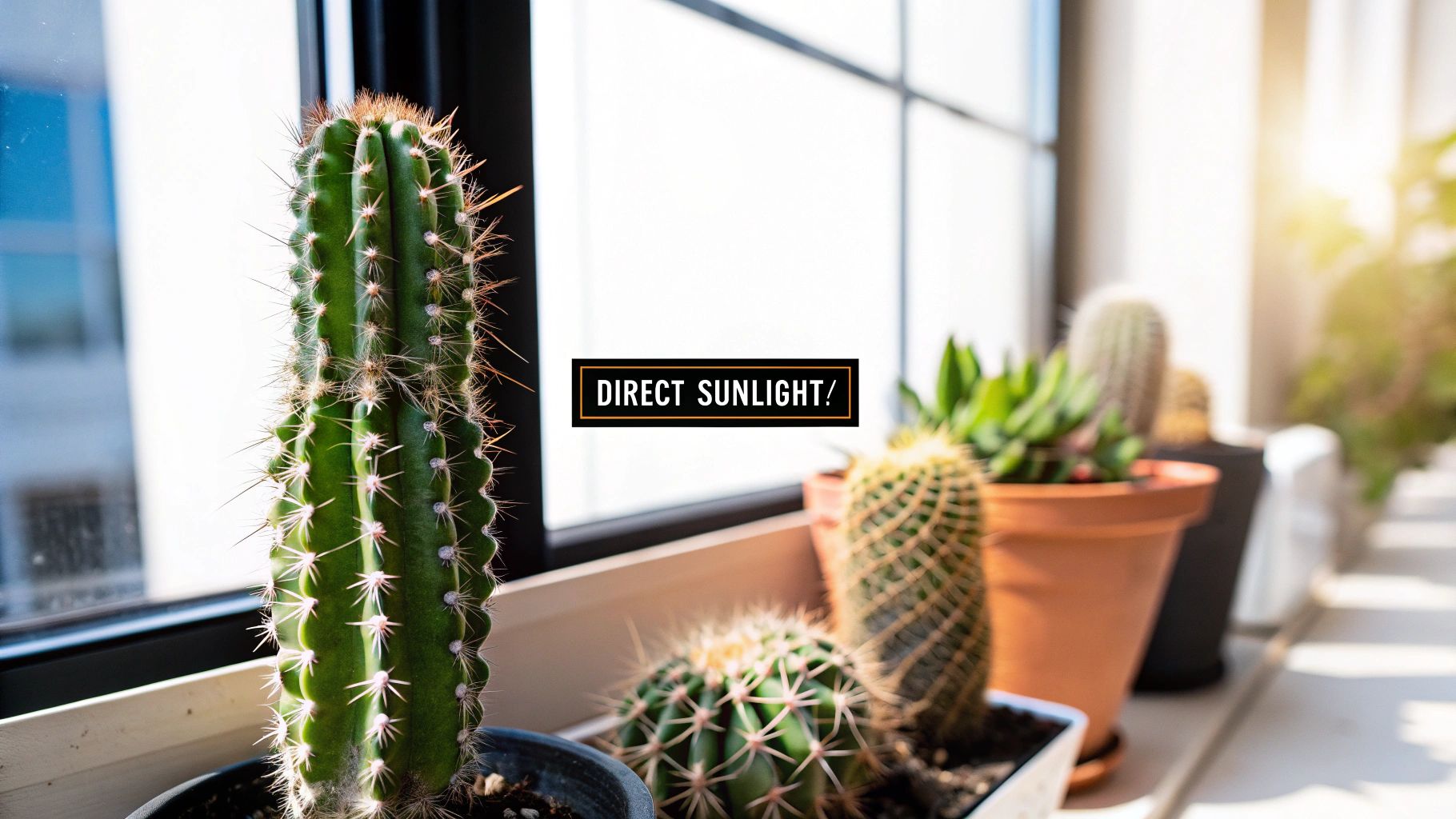Caring for a golden barrel cactus is surprisingly simple once you get the hang of it. The key is to mimic its native desert environment: give it plenty of full sun, a gritty, fast-draining soil mix, and deep but infrequent waterings. Even though these cacti are tough and slow-growing, getting these basics right will make all the difference.
Meet the Iconic Golden Barrel Cactus

Let's get acquainted with Echinocactus grusonii, a plant instantly recognizable for its striking spherical shape and brilliant golden-yellow spines. You might have heard it called the "Mother-in-Law's Cushion"—a playful nod to its prickly nature. It's a true icon, beloved in xeriscape gardens and indoor collections alike.
What really makes this cactus special is its incredible longevity. With the right care, a golden barrel can easily outlive its owner, slowly maturing into a magnificent, decades-old specimen.
This cactus hails from the rocky volcanic slopes of east-central Mexico, so it’s built to withstand tough conditions. Those deep, accordion-like ribs aren't just for looks; they allow the plant to swell up to store water after a rare downpour and shrink back down during long droughts. Understanding this adaptation is the first step to knowing what it needs from you.
A Story of Popularity and Peril
You can find golden barrels in nurseries and gardens all over the world, but their situation in the wild is a different story—a much sadder one. The plant's incredible popularity has, unfortunately, put its survival at risk.
Despite being a global favorite in horticulture, the golden barrel cactus is critically endangered in its native habitat. Overcollection and habitat loss have pushed wild populations to the brink.
This critical status highlights just how important it is to source your plants responsibly. To avoid contributing to the problem, always buy your golden barrel cactus from reputable growers who propagate them ethically and sustainably, rather than taking them from the wild.
Understanding the Barrel Cactus Family
The golden barrel is definitely the superstar of its clan, but it's not an only child. The "barrel cactus" label actually covers species from two main groups, Echinocactus and Ferocactus, and each has its own distinct personality.
Getting to know the extended family can give you a deeper appreciation for these desert survivors. If you're curious, you can dive into the fascinating world of the different https://www.cactusoutlet.com/blogs/blog/a-barrel-of-fun-exploring-different-types-of-barrel-cacti.
When you understand where this plant comes from, its slow and steady growth, and its conservation story, you start to see it differently. That knowledge is the foundation for providing care that helps your golden barrel do more than just survive—it helps it thrive.
Creating the Ideal Desert Environment at Home

If you want a truly happy golden barrel cactus, you need to think less like a gardener and more like a desert architect. This isn't your average houseplant. Success comes from recreating a slice of its native Chihuahuan Desert, which boils down to three key things: intense sun, gritty soil, and the right temperature range.
Nailing these fundamentals from the get-go is the secret to avoiding a world of common problems later. It’s not about fussing over your cactus daily, but about setting up the perfect environment so this slow-growing desert gem can thrive on its own terms.
To make things simple, here's a quick cheat sheet for the most important care requirements.
Golden Barrel Cactus Care At a Glance
| Care Aspect | Optimal Condition | Common Mistake to Avoid |
|---|---|---|
| Light | 6-8 hours of direct sunlight daily | Placing it in a low-light area, causing it to stretch or lean. |
| Soil | A fast-draining, gritty cactus mix | Using standard potting soil, which retains too much moisture and causes root rot. |
| Water | Deeply but infrequently; allow soil to dry out completely | Watering on a fixed schedule or letting it sit in a saucer of water. |
| Temperature | Thrives in heat above 100°F; cold hardy down to 20°F | Exposing it to prolonged freezes or sudden, drastic temperature changes. |
Keep these core principles in mind, and you'll be well on your way to raising a healthy, beautiful cactus.
Mastering Sunlight Indoors and Out
Golden barrels are total sun-worshippers, hardwired to soak up bright, direct light for most of the day. If you're planting one outside, find a spot that gets at least six to eight hours of direct sun. A south- or west-facing location is usually your best bet.
Growing indoors requires a bit more thought. A spot near a sunny window might not cut it. You need to give it the best seat in the house—right in front of your sunniest, typically south-facing, window where it can get blasted with light. If you see your cactus starting to lean towards the glass, that's its way of screaming for more sun.
My Favorite Tip: Don't be afraid to give your potted cactus a summer vacation outdoors. The raw, unfiltered sunlight does wonders for its growth and really brings out that vibrant golden color in its spines. Just make sure you acclimate it slowly!
Preventing a Sunburned Cactus
It sounds crazy for a desert plant, but yes, your golden barrel can get sunburned. This usually happens when you move a cactus from a cozy indoor spot directly into the intense summer sun without a transition period. You’ll see ugly, bleached-out patches on its skin that, unfortunately, are permanent scars.
Here’s how to acclimate it properly over a week or two to avoid this:
- First Few Days: Start with just an hour or two of direct morning sun. Keep it in bright, indirect light for the rest of the day.
- Mid-Week: Bump it up to three or four hours of direct sun, still aiming for that less intense morning light.
- End of the Week: Keep adding an hour or so every day until it’s happily soaking up the sun in its new home. This gradual process lets the cactus build up a tolerance.
The Perfect Soil: A Gritty Foundation
The number one mistake I see people make with these cacti is using the wrong soil. Standard potting mix is a death sentence. It’s designed to hold moisture, which is the exact opposite of what your golden barrel needs. Out in the desert, it grows in rocky, sandy soil where water vanishes almost instantly. That’s what you have to mimic.
Dense, soggy soil is a fast track to root rot, the undisputed champion of cactus killers. Your soil mix has to be incredibly porous and fast-draining. You'll know you've got it right when you water the pot and see it flow out the bottom drainage hole in just a few seconds.
For a deeper dive into crafting the perfect base for your desert plants, you'll find everything you need in our guide to cactus and succulent soil.
A Simple DIY Cactus Soil Recipe
You can always buy pre-made cactus soil, but mixing your own is easy, cheap, and often gives you a much better result. It puts you in total control of the drainage.
Here's my go-to recipe for a fantastic cactus mix:
- One part standard potting soil (for a bit of organic matter)
- One part coarse sand or poultry grit (this is key for texture)
- One part perlite or pumice (for aeration and lightning-fast drainage)
Just mix these three ingredients together thoroughly. When you grab a handful, it should feel gritty and fall apart easily, not clump up like garden soil. This simple blend is the perfect home for your cactus roots.
Temperature Tolerance: Heat and Cold
Native to the deserts of central Mexico, the golden barrel is a plant of extremes. It's incredibly heat-tolerant and can easily handle temperatures soaring above 100°F (38°C), especially with good air circulation.
What surprises many people is its resilience to cold. This cactus is hardy in USDA Zones 9a to 11 and can take a quick dip down to around 20°F (-6°C). While some have survived even colder snaps, prolonged freezing temperatures will kill it.
If you live in a colder climate, bringing your potted golden barrel inside before the first frost is non-negotiable. A cool, bright, and dry spot is perfect for letting it go dormant over the winter. For an in-ground cactus in a borderline zone, you can protect it from a rare freeze by covering it overnight with a frost cloth or an old blanket—just make sure the cover doesn't touch the cactus itself.
Watering and Feeding Your Golden Barrel

If there’s one mistake that new golden barrel owners make, it’s overwatering. I’ve seen more of these incredible cacti lost to good intentions and a heavy watering can than anything else. You have to completely reset your brain from how you water a typical houseplant.
Forget about a rigid weekly schedule. Watering every Saturday morning is a fast track to problems. Your cactus’s needs are going to shift dramatically with the seasons, the temperature of your home, and how much light it's getting.
Embrace the "Soak and Dry" Method
The best practice for any cactus is what we call the “soak and dry” method. It perfectly mimics the cycle of a rare but torrential desert downpour. When it's time to water, you water deeply. Then, you let the soil become completely bone-dry before even considering it again.
Here’s how it looks in practice:
- Drench the Soil: Take your pot to the sink and give the soil a thorough soaking until water pours out of the drainage holes. This ensures every root gets a chance to drink.
- Let It Drain Completely: Never, ever let your cactus sit in a saucer of standing water. This is the primary cause of root rot. Let it drain for a good 15-20 minutes before putting it back.
- Wait for It to Dry Out: This is the critical part. You must wait for the soil to dry out all the way through. Not just the top inch, but deep down in the pot.
Your best tool is your finger. I tell everyone to stick their finger at least two inches into the soil. If you feel any moisture at all, walk away. Don't water. Check again in a few days.
Learn to Read Your Cactus
Instead of relying on a calendar, learn to read the subtle cues your golden barrel gives you. This skill will make you a much more confident plant owner and ensures you’re responding to its actual needs.
For a deeper dive, our guide on how often to water a cactus breaks down seasonal changes in more detail.
Signs of Thirst (Underwatered):
- The accordion-like ribs start to look a bit shrunken or puckered.
- The whole plant might seem a little less plump.
- The top of the cactus may feel slightly soft when you press it gently.
Signs of Drowning (Overwatered):
- A sickly yellow or brown color starts creeping up from the base.
- The base itself feels soft, mushy, or even wobbly.
- The soil is constantly damp and might even have algae growing on top.
A mushy base is a red alert for root rot. If you see this, you need to stop watering immediately and take action to save your plant.
Adjusting for the Seasons
Your watering frequency should naturally follow the plant's growth cycle. It's active in the summer and goes dormant in the winter.
- Spring & Summer (Growing Season): As the days get longer and warmer, your cactus will be thirsty more often. You might find yourself watering every 2-4 weeks, but this depends heavily on heat and humidity. Let the soil be your guide, not the calendar.
- Fall & Winter (Dormancy): When the light fades and temperatures drop, your cactus hits the brakes and goes into a resting period. You need to reduce watering dramatically to maybe once every 6-8 weeks. Sometimes, an indoor cactus only needs water two or three times over the entire winter.
A Minimalist Approach to Fertilizing
Golden barrels are not heavy feeders. They come from harsh environments with lean soil, so trying to pump them full of fertilizer will only lead to weak, unnatural growth and can even burn their delicate roots.
The rule here is simple: less is more.
Look for a fertilizer made specifically for cacti and succulents. You want one that's low in nitrogen and higher in phosphorus and potassium to encourage strong roots, not just leafy growth. A formula like 5-10-10 is a great place to start.
Only feed your cactus during its active growing season in spring and summer. My go-to method is to use a liquid cactus fertilizer diluted to quarter-strength every other time I water.
Once fall sets in, stop all fertilizing. The plant needs to wind down for its winter rest. Pushing it to grow then just confuses it and creates weak spots vulnerable to the cold. This winter dormancy is essential for its long-term health and is often what triggers it to produce those beautiful yellow flowers once it's mature.
Time for a New Home: Repotting and Propagating
Sooner or later, your golden barrel will need a bigger pot. I know, the thought of wrestling with a cactus covered in those sharp, golden spines can be daunting, but it's a necessary step for its long-term health. Don't worry, I've got a few tricks up my sleeve to make it a safe and successful process.
Think of repotting as more than just an upgrade in size. It’s your chance to give the plant a fresh batch of nutrient-rich soil, check on the health of its roots, and set it up for a few more years of happy, if slow, growth.
The best time to tackle this is in the spring or early summer. This is when the cactus is kicking into its active growing season, which means it will recover from the move and settle into its new home much faster. A little planning goes a long way here.
How to Handle a Prickly Plant Safely
Alright, let's talk about those spines. Your average pair of gardening gloves won't cut it—those needles will go right through. You need to get a bit creative to protect your hands.
My go-to method is creating a DIY sling. I just grab an old, thick bath towel, a folded blanket, or even a stack of newspapers and wrap it snugly around the cactus. This gives you a thick, padded surface to grip so you can lift and guide the plant without turning into a human pincushion.
- For smaller plants: A sturdy pair of kitchen tongs can be surprisingly effective for gripping and moving the cactus without ever touching it.
- For the big, heavy ones: The towel sling is a must. You might even want to enlist a friend to hold the ends of the sling while you handle the pot.
The Right Pot and the Right Mix
When you're picking out a new pot, bigger isn't always better. A pot that's just one or two inches wider than the current one is the sweet spot. If you go too large, the excess soil will hold onto moisture for too long, creating the perfect conditions for root rot, which is the fastest way to kill a cactus.
And whatever you choose, make sure it has at least one large drainage hole. Terracotta pots are a fantastic choice because the clay is porous and helps the soil dry out evenly. Have your gritty, well-draining cactus mix ready to go before you even think about unpotting the plant.
This quick visual guide sums up the key points for a smooth repotting experience.

As you can see, getting the pot size and soil right from the start is half the battle.
Once you’re ready, gently turn the old pot on its side and tap it a few times to loosen the root ball. Using your protective sling, carefully slide the cactus out. Take a moment to inspect the roots. Healthy roots are firm and off-white. If you see any that are black, mushy, or dried out, trim them off.
Put a layer of your fresh cactus mix in the new pot, then center the cactus inside. Fill in the gaps around the root ball, making sure the cactus is sitting at the same soil depth as before. Lightly press the soil down to secure it.
Expert Tip: Wait at least a week before watering after repotting. This "dry spell" gives any roots that were bumped or broken during the move time to heal and form a callus. Watering too soon can invite rot right into those fresh wounds.
How to Propagate Golden Barrel Pups
Growing a golden barrel from a seed is an exercise in extreme patience—we're talking decades. A much quicker and more rewarding path is to propagate from the small offsets, or "pups," that sometimes appear around the base of a mature plant.
If you see a pup that’s at least a couple of inches wide, repotting is the perfect time to separate it. Take a clean, sharp knife and carefully slice it away from the parent plant. Try to get a few of its own roots along with it, but don't stress if you can't.
Next, place the pup in a dry, well-ventilated spot out of direct sun for several days. You need the cut area to dry out and form a hard callus. This is a critical step to prevent it from rotting when you plant it. Once callused, simply pot it up in a small container with cactus mix. Water it very lightly and infrequently until you see the first signs of new growth—that’s your proof that it has successfully rooted.
Solving Common Golden Barrel Cactus Problems
Even when you're doing everything right, your golden barrel can hit a rough patch. Don't worry—it happens. The great thing about these cacti is that they're pretty vocal when something's wrong, showing clear signs that can tell you exactly what they need.
Learning to read your cactus is the most important skill you can develop. Most issues you'll face boil down to a few common culprits: pests, disease, or a simple need for a tweak in your care routine. Spotting the signs early means you can get your plant back on track before any real damage is done.
What Your Cactus Is Trying to Tell You
Your cactus's body is a billboard for its health. A change in color, shape, or texture is your plant's way of sending up a flare. Here’s how to decipher those signals.
-
Yellowing or Browning: This is a big one. If you see a sickly yellow or brown color spreading up from the base and the area feels soft to the touch, that’s the classic sign of root rot from too much water. On the other hand, if an older cactus develops a tan, woody texture at its base, that's usually just natural corking—a sign of maturity. Yellow or white patches higher up on the body? That's likely a sunburn from being moved into intense sunlight too quickly.
-
Stretching (Etiolation): Is your beautiful, round barrel starting to look a bit like a cone? Or maybe it's leaning dramatically toward the window? This is called etiolation, and it's a dead giveaway that your cactus is starved for light. It's literally stretching itself out, reaching for more sun.
-
Shriveling: A healthy golden barrel has plump, accordion-like ribs. If those ribs start to look puckered or shrunken, your plant is thirsty. This is a clear signal that it's time for a good, deep watering.
Common Golden Barrel Cactus Issues and Solutions
Even seasoned growers run into issues now and then. This table is a quick-reference guide to help you diagnose what's going on and get your cactus back to its happy, spiky self.
| Symptom | Potential Cause | Recommended Action |
|---|---|---|
| Soft, mushy base | Root rot from overwatering | Stop watering immediately. Repot into dry soil, trimming any black or mushy roots. |
| White, cottony spots | Mealybugs | Dab spots with a cotton swab dipped in 70% isopropyl alcohol. For larger issues, use insecticidal soap. |
| Fine webbing on spines | Spider mites | Spray the cactus forcefully with water to dislodge them. Follow up with neem oil or insecticidal soap. |
| Pale, stretched growth | Lack of sunlight | Move the cactus to a location with at least 6-8 hours of direct, bright sunlight daily. |
| White or yellow scars | Sunburn | Move the plant to a spot with some afternoon shade or acclimate it to full sun more slowly. The scars are permanent. |
Think of this as your cactus first-aid chart. A quick look can usually point you in the right direction and save you a lot of guesswork.
Tackling Pests Head-On
While golden barrels are tough, they aren't completely immune to pests, especially when kept indoors away from their natural predators.
Mealybugs are probably the most frequent offenders. You'll spot them as tiny, white, cotton-like fluff tucked deep between the ribs or near the base. For a minor problem, just dip a cotton swab in rubbing alcohol and dab them directly. It’s surprisingly effective.
The key to pest management is consistency. Check your cactus weekly, paying close attention to the nooks and crannies where pests hide. Catching an infestation early makes it significantly easier to control.
Spider mites are another pest to keep an eye out for. They are incredibly small, and you often won't even see them—just the fine, delicate webbing they spin between the spines. They love hot, dry conditions. A strong blast of water from a hose is a great first step to physically knock them off the plant, followed by a treatment with horticultural soap or neem oil to handle any stragglers.
Your Golden Barrel Cactus Questions Answered
Even with the best care guide, you're bound to have a few questions pop up as you get to know your golden barrel cactus. Here are some of the most common things I get asked by fellow cactus growers, answered from real-world experience.
Why Is My Golden Barrel Cactus Turning Yellow or Brown?
A change in color is your cactus’s way of telling you something is wrong, and where it happens is the biggest clue.
If you spot yellowing or browning creeping up from the bottom of the plant, and that area feels mushy or soft, you’re almost certainly looking at overwatering and root rot. This is a serious problem. Stop watering right away and check the roots for damage.
On the flip side, a tan, corky texture developing at the base of an older, established cactus is usually just natural aging. Think of it as the plant building a stronger, more stable foundation—totally normal. But if you see bleached-out yellow or white patches on the top or sides, that's classic sunburn. It usually happens when a plant is moved into intense, direct sun too quickly. You can't reverse the damage, but you can prevent it by acclimating your cactus to its new sunny spot over a week or two.
Will My Indoor Golden Barrel Cactus Ever Flower?
It's a long shot, but it's not impossible! Getting those iconic yellow flowers is a true reward for dedication and patience. These cacti have to be quite mature before they even think about blooming—we're talking at least 15 years old and over a foot in diameter.
The real secret to coaxing an indoor golden barrel to bloom is to replicate its natural habitat's seasons. This means giving it a cool, dry winter rest period, followed by a warm, bright summer. That distinct environmental shift is what signals a mature plant to produce flowers.
To do this, you'll need to move your cactus to a spot where temperatures hover around 50°F (10°C) for the winter and stop watering it completely. This dormancy period is absolutely critical.
How Can I Tell If My Cactus Is Dormant or Dead?
It's a common worry, especially for new owners, but telling the difference is easier than you think. A dormant cactus is just resting for the winter. It won't put on any new growth, but it will stay firm to the touch and keep its healthy green color. It’s basically in a state of suspended animation.
A dead cactus, however, looks and feels dramatically different. It will become very soft, turn a sickly brown or even black, and might start to look hollow or even collapse on itself. If you give your plant a gentle squeeze and it feels solid, you can rest easy knowing it’s just sleeping and waiting for spring.
Ready to add a stunning, low-maintenance centerpiece to your collection? At The Cactus Outlet, we offer a curated selection of healthy, vibrant golden barrel cacti and other desert gems. Explore our collection and find your perfect plant today at https://www.cactusoutlet.com.




